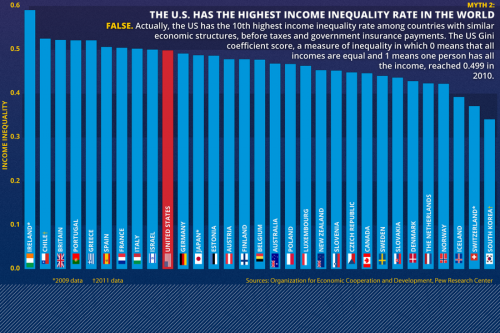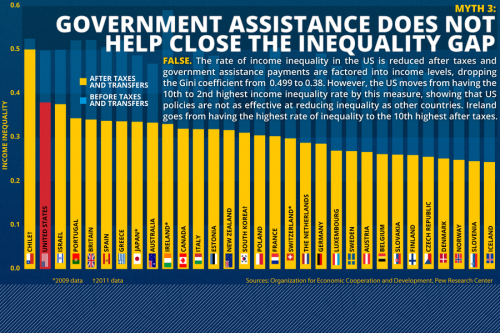Below are two figures. The first ranks the U.S. and other countries by income inequality before taxes and government interventions to reduce it. The second ranks the same countries after taxes and intervention.
What we see is that, whatever we’re doing to reduce inequality, it’s not working nearly as well as what other countries with high levels of income inequality are doing, with the sole exception of Chile.
Thanks to Christian Science Monitor for the images and Martin Hart-Landsberg for the tip.
Lisa Wade, PhD is an Associate Professor at Tulane University. She is the author of American Hookup, a book about college sexual culture; a textbook about gender; and a forthcoming introductory text: Terrible Magnificent Sociology. You can follow her on Twitter and Instagram.


Comments 5
Bill R — December 6, 2014
I would agree that even democratic governments have been fairly ineffective in reducing income discrepancies. (Russia and China? A complete joke.) Globalization of production exacerbates the problem by reducing the ability of unskilled workers to benefit from labor supply pressure within any one country; the larger supply pool keeps the price of unskilled/semi-skilled labor low.
But I see the real headline in the first graph differently from you. While a large n may show "significant" differences between countries, they don't appear to be "meaningful", especially among the very large economies like US, Briton, France, Germany and Japan.
The telling difference is less about country and more about disparity in education.
It is incredibly important to ID the true nature of the problem if you want to fix it. If you believe tax structure changes will do the job you implement different solutions than if you think equitable education needs to be addressed.
The truth is, None of Us Can Breathe – Bridget Magnus and the World as Seen from 4'11" — December 6, 2014
[…] yeah, the middle class can’t get ahead. People below the middle class aren’t even doing that well. And even though there is evidence that higher […]
Daniel Carrier — December 8, 2014
The US moved up a lot in the second chart, but that doesn't seem to mean much. The difference between income inequalities of different countries is much smaller than the difference government assistance makes. What we do may not work as well, but it seems to be pretty close. It would be more helpful to show a graph that compares it directly.
DO U.S. EFFORTS TO REDUCE INCOME INEQUALITY WORK? | Welcome to the Doctor's Office — December 24, 2014
[…] by Lisa Wade from SocImages […]
Micheal Jordan — June 21, 2023
This week's chart examining the effectiveness of U.S. efforts to reduce income inequality provides valuable insights into a complex and pressing issue.
Best Personal Training Studio in Queens New York